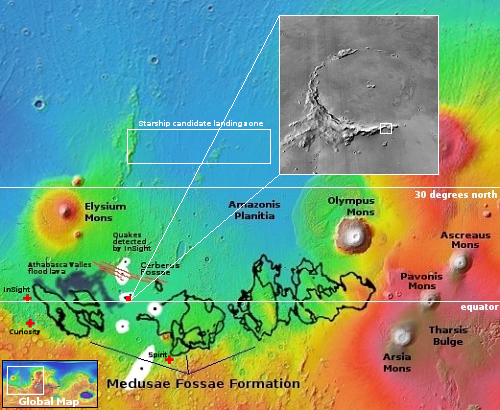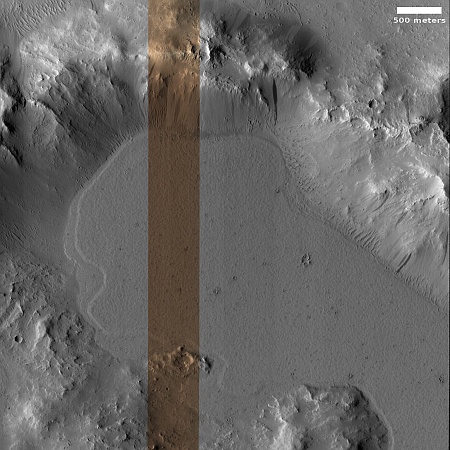The vast Martian plains of lava
Cool image time! The picture to the right, rotated, cropped, reduced, and sharpened to post here, was taken on January 31, 2024 by the high resolution camera on Mars Reconnaissance Orbiter (MRO). Labeled “Lava Embaying Highlands Ridge”, it shows an alcove along a ridgeline that appears filled with material, in this case solid lava.
If you look closely at the ridgeline, you can see several dark streaks on its southern slopes. These streaks could be one of two unique Martian features that remain unexplained. They could be slope streaks, which occur randomly through the year and fade with time, or recurring slope lineae, which occur seasonally at the same locations. In either case, though the streaks look like avalanches, they don’t change the topography, have no debris piles at their base, and even sometimes flow uphill for short lengths. Though there are a number of theories for their formation, many involving dust, none has been accepted as confirmed.
This location and its lava however are the stars of this picture, for a number of reasons, all revealed by the overview map below.

The red dot on the map to the right marks the location, located near the epicenter of two of the largest quakes detected by the seismometer on the InSight lander. The rectangle in the inset shows the area covered by the picture above, near the end of one arm of this crescent shaped ridge.
Evidently, that crescent is what remains visible of an ancient 50-mile-wide crater, with most of its eastern rim now buried by the same lava flow that is pushed up against this ridgeline. That lava is part of one or many flood events that covered this part of Mars for 600 miles to the east over a region about 500 miles wide, and likely occurred from half to than a billion years ago. I don’t know where the vent or vents for this lava is located, but I am sure geologists have located several candidates in pouring over MRO images.
Though the surface here is generally smooth and featureless, as the lava is relatively young, the recent quakes suggest things are happening below ground. It could be that there is some volcanic activity here, or if not the ground is still settling from those past volcanic events.
On Christmas Eve 1968 three Americans became the first humans to visit another world. What they did to celebrate was unexpected and profound, and will be remembered throughout all human history. Genesis: the Story of Apollo 8, Robert Zimmerman's classic history of humanity's first journey to another world, tells that story, and it is now available as both an ebook and an audiobook, both with a foreword by Valerie Anders and a new introduction by Robert Zimmerman.
The print edition can be purchased at Amazon or from any other book seller. If you want an autographed copy the price is $60 for the hardback and $45 for the paperback, plus $8 shipping for each. Go here for purchasing details. The ebook is available everywhere for $5.99 (before discount) at amazon, or direct from my ebook publisher, ebookit. If you buy it from ebookit you don't support the big tech companies and the author gets a bigger cut much sooner.
The audiobook is also available at all these vendors, and is also free with a 30-day trial membership to Audible.
"Not simply about one mission, [Genesis] is also the history of America's quest for the moon... Zimmerman has done a masterful job of tying disparate events together into a solid account of one of America's greatest human triumphs."--San Antonio Express-News
Cool image time! The picture to the right, rotated, cropped, reduced, and sharpened to post here, was taken on January 31, 2024 by the high resolution camera on Mars Reconnaissance Orbiter (MRO). Labeled “Lava Embaying Highlands Ridge”, it shows an alcove along a ridgeline that appears filled with material, in this case solid lava.
If you look closely at the ridgeline, you can see several dark streaks on its southern slopes. These streaks could be one of two unique Martian features that remain unexplained. They could be slope streaks, which occur randomly through the year and fade with time, or recurring slope lineae, which occur seasonally at the same locations. In either case, though the streaks look like avalanches, they don’t change the topography, have no debris piles at their base, and even sometimes flow uphill for short lengths. Though there are a number of theories for their formation, many involving dust, none has been accepted as confirmed.
This location and its lava however are the stars of this picture, for a number of reasons, all revealed by the overview map below.

The red dot on the map to the right marks the location, located near the epicenter of two of the largest quakes detected by the seismometer on the InSight lander. The rectangle in the inset shows the area covered by the picture above, near the end of one arm of this crescent shaped ridge.
Evidently, that crescent is what remains visible of an ancient 50-mile-wide crater, with most of its eastern rim now buried by the same lava flow that is pushed up against this ridgeline. That lava is part of one or many flood events that covered this part of Mars for 600 miles to the east over a region about 500 miles wide, and likely occurred from half to than a billion years ago. I don’t know where the vent or vents for this lava is located, but I am sure geologists have located several candidates in pouring over MRO images.
Though the surface here is generally smooth and featureless, as the lava is relatively young, the recent quakes suggest things are happening below ground. It could be that there is some volcanic activity here, or if not the ground is still settling from those past volcanic events.
On Christmas Eve 1968 three Americans became the first humans to visit another world. What they did to celebrate was unexpected and profound, and will be remembered throughout all human history. Genesis: the Story of Apollo 8, Robert Zimmerman's classic history of humanity's first journey to another world, tells that story, and it is now available as both an ebook and an audiobook, both with a foreword by Valerie Anders and a new introduction by Robert Zimmerman.
The print edition can be purchased at Amazon or from any other book seller. If you want an autographed copy the price is $60 for the hardback and $45 for the paperback, plus $8 shipping for each. Go here for purchasing details. The ebook is available everywhere for $5.99 (before discount) at amazon, or direct from my ebook publisher, ebookit. If you buy it from ebookit you don't support the big tech companies and the author gets a bigger cut much sooner.
The audiobook is also available at all these vendors, and is also free with a 30-day trial membership to Audible.
"Not simply about one mission, [Genesis] is also the history of America's quest for the moon... Zimmerman has done a masterful job of tying disparate events together into a solid account of one of America's greatest human triumphs."--San Antonio Express-News



And this just in:
https://skyandtelescope.org/astronomy-news/giant-ancient-volcano-discovered-on-mars/
From the post:
Similarly, the researchers think that the giant Noctis Mons volcano was built like a layered cake, alternating deposits of ice and volcanic material. The slopes of the mesas show evidence of this, because there salt deposits alternate with layers of volcanic material and now-solid lava flows.
Taken together, the eroded volcano and the remnant of the glacier suggest that the volcanic blanket in this large region may be concealing a vast sheet of glacier ice beneath its surface.
“Finding this interaction between buried glaciers and magmatism is very positive, and it’s connected with topics such as habitability and the likelihood of finding biosignatures,” Rodriguez says. “If it’s really true, it would be a very important discovery.”
Touching on some if the host of this site’s speculations about how geological processes “work” on Mars, there is also this:
This finding connects with the team’s previous discovery of a nearby sulfate-salt deposit, which has shapes and features resembling those of a glacier. Lee and his collaborator, graduate student Sourabh Shubham (University of Maryland, College Park), think that this glacier-like feature formed when a layer of volcanic ash landed on top of a glacier. The ash reacted with the acidic water and turned into a salty mineral called jarosite, forming deposits that mimicked the shapes of the glacier underneath it, like plaster in a mold. Later on, some sort of erosive process removed the upper layers of ash, revealing the glacier-like salt layers.
Ancient, fossilized glaciers. A strange world of fire and ice.